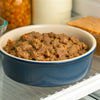How Much Should I Feed My Dog Wet Food? A Comprehensive Guide
- Houndsy
Table of Contents
- Introduction
- The Importance of Proper Feeding for Dogs
- Understanding Feeding Guidelines for Canned Dog Food
- Calculating the Right Amount of Canned Food Based on Your Dog's Weight
- Considerations for Mixing Canned and Dry Food
- Adjusting Feeding Based on Life Stages and Health Needs
- Conclusion
Introduction
Did you know that around 59% of dogs in the United States are classified as overweight or obese? As devoted pet owners, we understand that ensuring our furry friends' health starts with one of the most critical yet often confusing tasks: feeding. If you’re asking yourself, “how much should I feed my dog wet food?” you’re not alone. Many dog parents struggle with this question, navigating through varying recommendations, portion sizes, and the unique needs of their pets.
In this blog post, we’ll address the intricacies of feeding wet dog food, focusing on how much to serve based on various factors such as weight, age, and activity level. By the end, you'll not only know the appropriate portions but also understand how to make informed nutritional choices for your beloved pup, making their eating experience both healthy and enjoyable.
Let’s dive into critical aspects including feeding guidelines, calculations based on your dog's weight, considerations for mixing wet and dry food, and how to adapt feeding based on your dog’s life stages. Engaging with this topic will empower you to enhance your pet’s daily feeding routine, ensuring they flourish in both health and happiness.
The Importance of Proper Feeding for Dogs
Feeding your dog the correct portion of high-quality food is essential—not only for satisfying their appetite but also for maintaining overall health. Mismanagement of dog feeding can lead to obesity, which can be attributed to serious health issues such as diabetes, heart disease, and joint problems. Conversely, underfeeding can cause nutritional deficiencies leading to lethargy, weakened immune systems, and even more severe health concerns over time.
Understanding portion sizes is critical, especially considering that many pet owners are inclined to guess or eyeball serving sizes. At Houndsy, we prioritize simplifying your pet care experience, which is why our innovative solutions, like the Houndsy Kibble Dispenser, offer perfect portion control in a beautifully designed package.
Key Takeaways
- Avoid Overfeeding: Can lead to obesity and various health complications.
- Prevent Underfeeding: Necessary nutrients may be missed, affecting overall energy and health.
- Consistent Portions: Essential for maintaining a healthy weight and monitoring body condition.
- Innovative Solutions: Products like our Houndsy Kibble Dispenser support convenient and worry-free feeding.
Understanding Feeding Guidelines for Canned Dog Food
Each can of dog food comes with feeding guidelines that usually vary based on weight. Recognizing your dog’s ideal weight is crucial for ensuring they receive the right amount of food per day. Too often, pet owners assume that "one can" is a "one-size-fits-all" solution; however, that’s not usually the case.
General Feeding Recommendations
Most wet dog foods suggest feeding your dog roughly one 3 oz can for every 3-3.5 pounds of body weight divided into multiple meals. It’s vital to keep in mind that every brand may have slight variations and adjustments should be made according to the caloric density of the specific food. Below is a simple guide:
- Under 10 pounds: 1/4 to 1 can per day
- 10 to 20 pounds: 1/2 to 1 can per day
- 20 to 40 pounds: 1 to 1.5 cans per day
- 40 to 60 pounds: 1.5 to 2 cans per day
- 60 to 80 pounds: 2 to 2.5 cans per day
- 80 to 100 pounds: 2.5 to 3 cans per day
Adapting these guidelines to your dog’s lifestyle, activity level, and specific health needs will provide a solid foundation for their nutrition.
Calculating the Right Amount of Canned Food Based on Your Dog's Weight
To calculate how much wet food to feed your dog, follow these pragmatic steps:
- Determine Your Dog's Ideal Weight: Consult with your veterinarian to establish what weight would be healthy for your dog based on their breed and age.
- Check the Feeding Guidelines: Review the feeding guidelines that come with the specific dog food you choose.
- Calculate Daily Portions: For instance, if your 30-pound dog requires a 1 can per 15 pounds, that implies 2 cans per day.
- Divide Into Meals: If your dog is accustomed to two meals a day, each portion would consist of 1 can at each meal.
- Monitor and Adjust: Observe your dog’s weight and overall health. Collaborate with your vet to adapt their food intake if necessary.
Example Calculation
Let’s say we have a 50-pound dog. Based on general recommendations, they should ideally receive 1.5 to 2 cans of food per day. If we're to follow the midpoint, that translates to 1.75 cans daily, serving approximately 0.875 cans per meal if dividing into two meals.
Maintaining Consistency
Using a measuring device or a container dedicated to your dog’s feed will simplify maintaining accurate feeding portions—our Houndsy Kibble Dispenser ensures reliable portions effortlessly!
Considerations for Mixing Canned and Dry Food
Many pet owners opt to mix canned and dry food to provide their dogs with a diverse dietary experience. This practice not only enhances palatability but also offers nutritional variety. However, it is vital to balance portion sizes carefully to avoid unintended overfeeding.
Best Practices for Mixing Foods
- Adjust Portions: When you incorporate wet food into your dog's meals, reduce the dry food of your daily intake accordingly. A common recommendation is to subtract about 1/3 cup of dry food for every half can of wet food added.
- Monitor Caloric Intake: Ensure the total caloric intake remains appropriate for your dog's weight and activity level.
- Experiment with Ratios: Each dog is unique, and it may take time to find their preferred wet-to-dry food ratio while maintaining a balanced and nutritious diet.
Benefits of Mixing
- Increased Palatability: Wet food makes meals more enticing for picky eaters.
- Enhanced Hydration: The moisture content in wet food is beneficial for hydration.
- Nutritional Variety: Offering different food types provides a broader range of nutrients.
By adjusting the portions accordingly, you can seamlessly incorporate the health benefits of both wet and dry food. Using the Houndsy Kibble Dispenser allows for hassle-free switching between kibble and wet food, ensuring that the feeding experience remains consistent and enjoyable.
Adjusting Feeding Based on Life Stages and Health Needs
As our dogs grow and their lifestyles evolve, their nutritional requirements change as well. Puppies, adults, and senior dogs all have distinct needs which should be reflected in their diets.
Puppies
Puppies require more calories and nutrients to support their rapid growth. Depending on their age and size, they may need 2 to 4 times the regular amount of wet food compared to adult dogs. Always consult with your veterinarian to establish specific recommendations for your puppy’s diet.
Adult Dogs
For adult dogs, maintaining consistent feeding schedules while adjusting for activity levels is key. Active dogs may require more food to meet their energy needs, while sedentary dogs may need less for maintenance.
Senior Dogs
Older dogs typically need fewer calories as their activity levels decrease. Additionally, it's crucial to choose wet dog foods formulated specifically for seniors, which may contain joint-supporting nutrients. Regularly monitor their weight and health, and adjust portions accordingly.
Special Health Considerations
Dogs with chronic health issues may require tailored diets. Whether it’s training adjustments for allergies, weight control, or other health conditions, it’s imperative to work closely with your veterinarian to develop a dietary plan that meets your dog’s unique needs.
Conclusion
Ultimately, knowing how much wet food to feed your dog is vital for their health and happiness. Utilizing guidelines based on their weight, adjustments for mixed feeding, and accounting for their age and health requirements will create a balanced approach to feeding.
At Houndsy, we strive to simplify pet care with innovative products like the Houndsy Kibble Dispenser, which ensures effortless portion control, enhancing both your and your pup’s mealtime experience.
We want to empower you to make nutritious and confident feeding decisions for your pets by understanding their dietary needs and behaviors. If you’re ready to elevate your dog feeding experience, explore our convenient and beautifully designed products that make feeding a joy.
FAQ
-
How do I know how much canned food to feed my dog? Start by checking the feeding guidelines on the canned food label based on your dog's weight. Consult your vet for personalized recommendations.
-
Can I mix canned food with dry food? Yes! Mixing canned food with dry food can enhance palatability and provide additional hydration. Just be sure to adjust portion sizes to avoid overfeeding.
-
How many meals should I feed my dog each day? Most adult dogs thrive on two meals a day. Puppies may need 3 to 5 meals, while senior dogs may benefit from two meals but consult your vet for tailored advice.
-
What if my dog is overweight? If your dog is overweight, consult your veterinarian to develop a weight management plan, including appropriate feeding amounts and exercise.
-
Are there specific dietary needs for senior dogs? Yes, senior dogs may require lower calorie foods and include joint-supporting nutrients. Always consult your veterinarian for tailored dietary recommendations.












